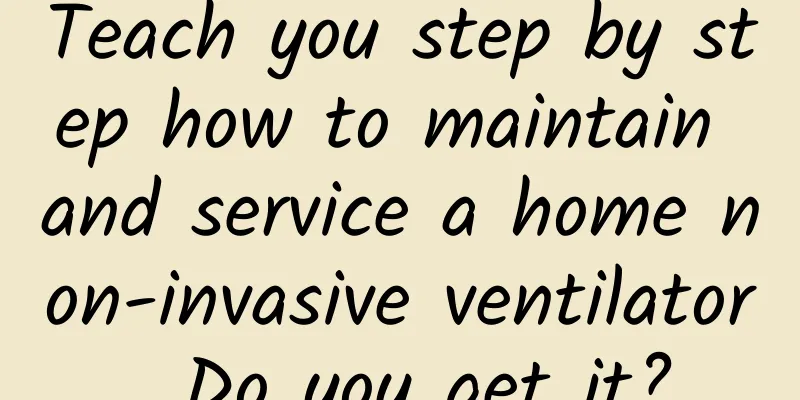Teach you step by step how to maintain and service a home non-invasive ventilator. Do you get it?

|
Home non-invasive positive pressure ventilation therapy, that is, sequential supportive treatment from hospital to home, is commonly used in patients with chronic obstructive pulmonary disease, sleep apnea hypopnea syndrome, etc. Studies have shown that this treatment can directly improve patients' symptoms and improve their quality of life. For patients with chronic obstructive pulmonary disease, home non-invasive positive pressure ventilation therapy can effectively reduce acute attacks of the disease and the number of hospitalizations, reduce medical expenses, and alleviate the economic burden on society and families. As people's living standards improve, the usage rate of home non-invasive ventilators is getting higher and higher. However, non-invasive ventilators are clinical treatment equipment, not household appliances. The usage specifications are not a simple operation. The ventilator, pipeline, and mask are suitable for the growth of bacteria such as Escherichia coli, Staphylococcus aureus, and Candida albicans due to the high temperature and humidity when in use. If not disinfected and sterilized in time, a large number of bacteria will enter the human respiratory tract with the airflow, posing a great health threat to patients. Therefore, the cleaning and maintenance of home ventilators and accessories are very important. Today, an expert from the Respiratory Department of Hunan Provincial Hospital of Traditional Chinese Medicine will share with you the precautions for the maintenance and care of home non-invasive ventilators. 1. Cleaning and maintenance of the outside of the ventilator Use a lint-free soft cloth dampened with water to wipe the outer surface of the ventilator, then wipe it dry with a dry soft cloth. If there is contamination, wipe it with alcohol gauze. Note: It is strictly forbidden to rinse with water or allow water to enter the machine; disconnect the power supply before cleaning; the ventilator should be placed in a dry and ventilated place, away from direct sunlight. 2. Cleaning and maintenance of nose (oral and nose) masks and headbands The nose (oral and nose) mask is in contact with the skin for a long time and will be contaminated with grease. It is recommended to wipe it with a lint-free soft cloth dampened with water every day and clean it with a neutral detergent once a week. When cleaning, disassemble the nose pad, forehead pad, frame and other parts, put them in cold water containing neutral detergent, rinse them under running water after cleaning, and dry them. During use, the silicone of the nasal (oral and nose) mask will gradually turn yellow, harden and age, causing air leakage and affecting comfort. It is recommended to replace it in time when it is uncomfortable to use or the sealing effect is poor. The headband can be cleaned once a week with a neutral detergent, dried and used. If there is obvious contamination, clean it at any time. 3. Cleaning and replacement of air filter cotton The non-invasive ventilator inhales a large amount of air from the air inlet every day. Large dust particles will be intercepted by the filter cotton, and small dust particles will enter the machine, gather inside the motor, and then enter the human body with the air. At the same time, a dirty filter membrane may cause the device to have a high temperature when working, thus affecting the performance of the ventilator. The filter cotton of some ventilators can be cleaned. Just rinse it with running water, gently, rinse it clean and dry it for later use. Generally, clean it every month and replace it every six months. Make sure the reinstalled filter cotton is completely dry. 4. Cleaning and maintenance of pipelines Most ventilator tubes can be reused. It is recommended to soak and clean them with a neutral detergent. Make sure the tubes are dry before use. Tubes that have been used for a long time should be checked regularly for leaks and replaced in a timely manner. 5. Cleaning and maintenance of ventilator humidifier tank After use, disconnect the power supply, take out the humidifier tank, pour out the remaining water, rinse with running clean water or use a neutral detergent and then rinse with clean water. After cleaning, place it in a cool place to dry naturally, and do not expose it to the sun or dry it in a dryer to avoid damaging the humidifier. Note that the humidifier requires pure water to prevent scale. The water level cannot exceed the maximum water level. It is recommended to change the water every day. When not in use, the liquid remaining in the humidifier should be poured out to avoid the humidifier liquid being heated for too long, which may lead to bacterial growth and respiratory infections. In short, the disinfection, maintenance and care of the ventilator is an important and complex task, which is crucial to improving the success rate of non-invasive ventilation, extending the service life of the ventilator, and giving full play to the use value of the ventilator. Hunan Medical Chat Special Author: Xie Chuxiang, Department of Respiratory Medicine, Hunan Provincial Hospital of Traditional Chinese Medicine Follow @湖南医聊 to get more health science information! (Edited by YH) |
>>: Beware of "height-increasing product" scams and understand height growth scientifically
Recommend
Can I get pregnant three or four days after my period?
Three or four days after a woman's menstruati...
What are the side effects of the IUD? What should I pay attention to when taking out the IUD?
In the modern world, many women choose to wear IU...
How to win back a woman's heart
It is inevitable for couples to encounter problem...
Can pregnant women smell chrysanthemums?
In traditional Chinese medicine, chrysanthemum is...
Can I drink monk fruit during menstruation?
Monk fruit is a fruit with health-preserving and ...
How long does it take to get pregnant after hysteroscopy?
Everyone must be familiar with hysteroscopy and l...
Blood sugar standard values for pregnant women 7 times a day
During pregnancy, the mother needs to do many rou...
Vaginitis is divided into several types
Vaginitis is a very common gynecological disease....
What does it mean when menstruation is black?
Usually, many girls do not avoid certain foods du...
What is the progesterone level at 40 days of pregnancy?
Generally, women need to pay special attention to...
Why do humans get cancer? Is cancer a legacy of evolution?
Why do people get cancer? We can explain it from ...
Tips for quick pain relief when you have a toothache caused by internal heat What fruits should you not eat when you have a toothache caused by internal heat
Toothache is a very uncomfortable thing, especiall...
Such a combination of women can lead to gynecological diseases
As the severe winter approaches, many female frie...
Can I drink rice porridge during confinement?
During the confinement period, your body needs to...
The fastest way to get pregnant
Many female friends are very concerned about the ...









